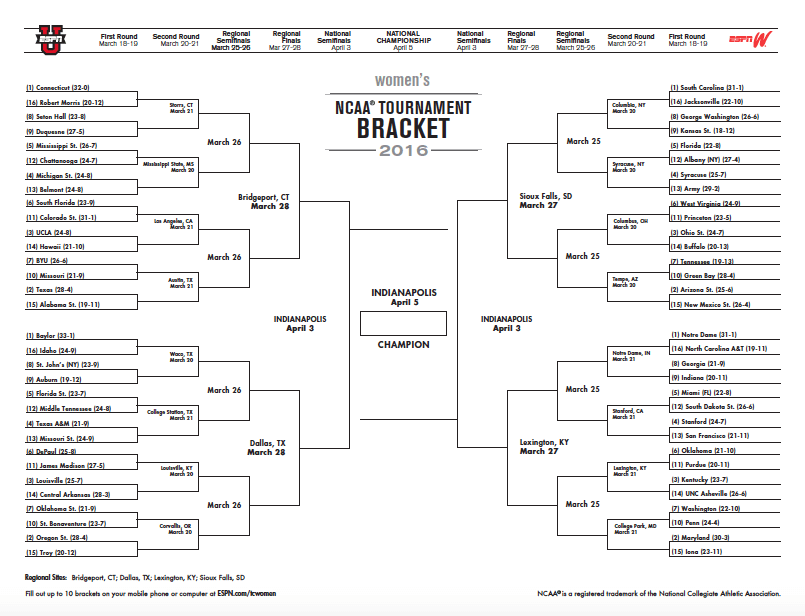
A few thoughts off the top of my overheated head about the 2016 NCAA women’s tournament bracket, whose unveiling on ESPN on Monday night was about as eventful as many believe the final outcome will be in a couple of weeks in Indianapolis:
- The NCAA women’s basketball selection committee really strained to fill this 64-team bracket, more than usual, and this has been increasingly difficult to do for quite a few years now;
- Nothing against the SEC receiving nine bids, tying the most for any conference in any year with the Big East in 2011;
- However, aside from South Carolina and possibly Kentucky (more on that in a moment), I don’t see any other realistic Final Four routes in this bracket for SEC teams. I came down hard on how SEC teams have been offensively challenged this season, and hope that doesn’t hurt them in the NCAAs. But after watching the SEC tournament, I’m not optimistic;
- Three of the other major conferences received only five bids each, which is revealing. Like the SEC to some degree, teams in the ACC, Big Ten and Pac 12 really beat one another up. Some teams, like Minnesota, didn’t play good non-conference schedules, and others, like N.C. State, had losses to low-RPI teams (Elon, Wake Forest);
- This opened up the door for some surprising at-large bids in mid- and small conferences. Princeton is the first Ivy League at-large team ever, with a 36 RPI and a good win over Duquesne, which is making its first NCAA berth. A third team from the Atlantic 10 is St. Bonaventure, which had Top 50 RPI wins over James Madison, Duquesne and A-10 champ George Washington;
- Those wins might not have been strong enough in previous seasons to secure an NCAA berth, but there just weren’t many better bubble teams to consider;
- There were some complaints that some non-major conference teams got frozen out, namely Florida Gulf Coast, which was upset by Jacksonville in the Atlantic Sun final. But an RPI of 70 undercut a good Top 50 RPI win over GW. Teams with good RPIs were amply rewarded, and while this is nothing new, that formula (however flawed it may be) was especially crucial this year.
All of which makes it hard to argue with the committee’s selections in any significant way. The only major head-scratcher was placing South Carolina, the overall No. 2 seed, in the Sioux Falls regional, which would require a potential longer travel distance than Notre Dame, the No. 3 overall seed, which is in the Lexington region.
Committee chairwoman Chris Dawson said the Gamecocks would have to fly either way, while Notre Dame could bus down from South Bend. Last year, the Fighting Irish had longer travel as the No. 2 overall seed, going to Oklahoma City, than South Carolina, which easily bused to Greensboro.
So maybe that has evened out, but it has also created a precedent in breaking committee principles of rewarding higher seeds with easier travel.
Dawson made a vague reference to “student-athlete welfare” and the difficulties of balancing the bracket, which is a certain way of admitting that the committee wasn’t going to ship out Kentucky in favor of the SEC champions.
Kentucky coach Matthew Mitchell said what Dawson wouldn’t, not long after learning his team would not have to leave home in its bid for the program’s first Women’s Final Four:
“The overall goal of the tournament is to be very competitive, but also be more successful financially. I’m not surprised from that standpoint. But that’s what they wanted, people that wanted women’s basketball and wanted these regionals. They wanted you to step up and bid, and that’s what the University of Louisville did a couple years ago, that’s what we’ve done now.”
Bingo.
Lexington is a regional host in 2017 and 2018 as well, and the post-Ackerman White Paper desire for better crowds and revenues in the NCAA women’s tournament figures to drive more decisions like these.
This may not make coaches or others calling for a more “fair” NCAA women’s tournament happy, not any more than the committee’s decision to place 2014 regionals on the home floors of Nebraska, Louisville, Notre Dame and Stanford.
But regional attendance at the NCAA women’s tournament has been inconsistent for years, and has depended largely on something of a local draw.
Frankly, I think a super regional format, like is used in baseball and softball, might be the best way to address this issue. Or in a roll of the dice, a Sweet 16 in Las Vegas, as Debbie Antonelli has been championing.
Why not? Some bolder steps have been needed for a while, beyond the piecemeal changes recommended by Val Ackerman.
It’s not just UConn’s smothering dominance that makes this bracket so unsuspenseful. Don’t get me wrong; there are plenty of good early-round matchups here, and this has been the case in the NCAA women’s tournament for a few years.
Next year the Huskies don’t figure to be as heavily favored as they are now. Notre Dame, South Carolina, Baylor, Ohio State, Maryland and others will have more of their best players returning, and outstanding recruiting classes coming in.
We may see some actual parity on the court deep into March and April that hasn’t been the case for a few years.
Wendy Parker is a sportswriter and web editor who has covered women's basketball since the early 1990s. She is a correspondent for Basketball Times and formerly covered women's and college sports, soccer and the Olympics at The Atlanta Journal-Constitution. She is the author of "Beyond Title IX: The Cultural Laments of Women's Sports," available on Amazon, and the creator of Sports Biblio, a blog about sports books and history.




